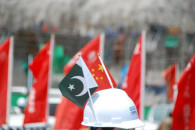Bankers beware: How to prevent the next financial crisis
The year 2012 is expected to bring another severe financial crisis, unless the banks are smarter this time around.

High inflation may be hurting consumers, but it has not been too bad for business as the better-than-expected increases in corporate profitability illustrate. High inflation also translates into higher interest rates, which tends to be good for the banks’ bottom line, at least in the short run.
Having gone through an excruciatingly painful financial crisis in late 2008, a recovery in the profitability of the banking sector is welcome news for the economy. Yet it may not be set to last. Given the consistent inability of the federal government to control its fiscal deficit, a second financial crisis is becoming all but inevitable.
But while the banks can do nothing to prevent the conditions of crisis from taking hold, they can do quite a bit to control the level of damage inflicted upon them when the crisis eventually does hit. They can start by taking advantage of the fact that their incomes are set to get better before they get worse.
2011: All set for a great year
The banks have had a stellar recovery from the last financial crisis of 2008. For the first nine months of 2010, the incomes of the 21 publicly listed banks increased by an impressive 15.7 per cent compared to the same period in the previous year. Excluding the catastrophic results at NIB Bank, that figure was an even higher 25.3 per cent and does not include what is, by all accounts, an outstanding fourth quarter.
For 2011, most banks are predicting even higher profitability. Indeed, some are looking to record-breaking growth prospects.
“I am looking at 100 per cent growth in our bottom line,” said one executive at Standard Chartered Bank who wished to remain anonymous.
Analysts suggest that there may indeed be room for optimism in banking sector earnings. As interest rates rise, banks will be able to charge higher rates on their lending, but will not correspondingly increase the interest rates they pay out to most of their depositors.
“The banking sector’s spread should increase in the fourth quarter of 2010,” said Hamza Marath, a research analyst at KASB Securities, in a note issued to clients this week. The banking spread – also known as the net interest margin – refers to the difference between the interest rate banks charge on their lending and the interest rates they pay out to their depositors.
With a dearth of options for fixed income investing, most Pakistanis continue to deposit their funds into banks, despite the abysmally low returns on savings accounts. Most depositors earn nothing on their current accounts and only about 5 per cent on their savings accounts. These two categories account for as much as two thirds of all banking sector deposits.
On the lending side, banks charge an interest rate based on a benchmark known as the Karachi Interbank Overnight Rate (KIBOR). As of Friday, the 6-month KIBOR, the most commonly used variant of the benchmark, was at 13.76 per cent. Yet this is not the interest rate most companies pay. The actual rate of interest can be as much as three to four per cent higher than the benchmark.
Given these trends, higher profitability for banks seems like a foregone conclusion.
2012: Bring the pain
High interest rates, however, have a substantial downside. At some point, the interest rates become too high for many banking customers to pay. And when that happens, default rates start to rise and the banks’ earnings start to plummet as they set aside more and more of their revenues to cover the losses from loans gone bad.
So how high would interest rates have to go before the financial services sector starts to suffer? The history of the 2008 financial crisis suggests that we may be very near that point already.
Leading indicators of inflation, such as the wholesale price index (WPI) – statistics that point to the direction of not current but future inflation – suggest that inflation crossing the 20 per cent mark or even the 25 per cent mark that was reached in August 2008. These higher levels of inflation and interest rates will begin appearing at the end of 2011 and will be compounded in 2012, when the federal government’s deficit will go into further trouble on account of having to begin repayments on foreign loans.
When this happens, default rates will start to rise and banks will run into trouble. That trouble, however, will be compounded by another problem: as a means of trying to get the economy out of the last crisis, the central bank had reduced the capital adequacy requirements for banks, meaning they have less money to cushion them against losses than they did before the 2008 crisis.
The State Bank’s actions were not entirely without reason. Reducing the bank’s capital requirements revived lending activity and helped the economy begin its recovery. But once banks were back on their feet, they should have been tightened again, which has not yet happened.
Another way out
While the State Bank does not legally require the banks to raise their capital reserves, the banks have a unique opportunity to do so on their own. If, as expected, profits rise substantially in 2011, most banks will have a substantial amount of cash that can deployed towards their reserves in anticipation of the all but inevitable crunch that will hit the sector the following year.
Whether or not banks view the coming crisis as a credible threat is an open question. Given the fact the previous crisis was only three years ago, the sector is not yet suffering from the irrational exuberance that typically precedes most financial crises. It is entirely likely that these considerations are already on the minds of most senior bankers.
Published in The Express Tribune, February 7th, 2011.

















COMMENTS
Comments are moderated and generally will be posted if they are on-topic and not abusive.
For more information, please see our Comments FAQ